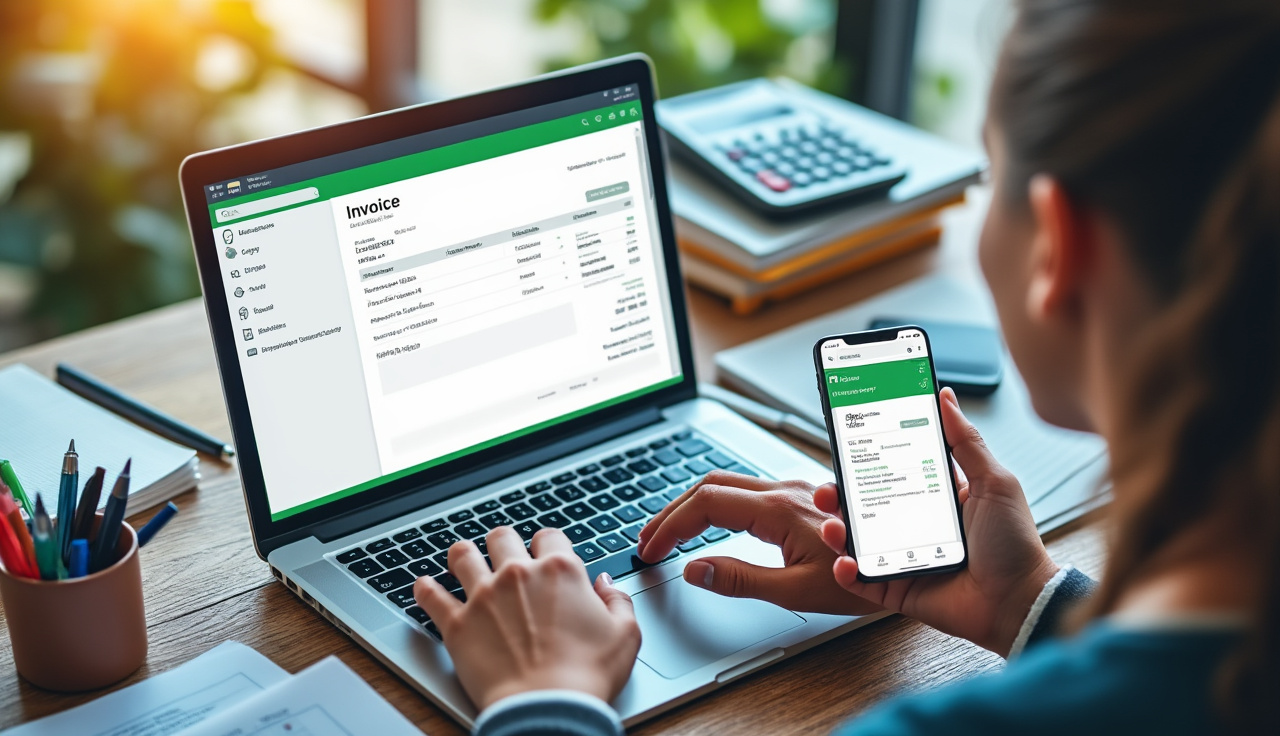QuickBooks Invoicing Tools & Payment Solutions

QuickBooks invoicing isn’t just about sending bills—it’s your shortcut to growing profits while ditching paperwork. Picture this: tools that slash hours spent on admin tasks and speed up payments. That’s the power of blending invoice automation with financial management in one dashboard.
Here’s the kicker: most businesses miss out on hidden gems like multi-currency support (think: hassle-free global deals) or dispute analytics (spot payment fights before they blow up). These underused features aren’t just cool tricks—they’re proven to boost ROI. For example, companies using QuickBooks’ automation tools report 20% faster payments and 30% fewer invoice errors.
Why does this matter? Simple: every minute saved on chasing payments means more time to focus on what actually grows your business. QuickBooks turns invoicing from a chore into a cash flow engine, giving you real-time insights to make smarter decisions. Ready to stop leaving money on the table? Let’s dive in.
Automating Cash Flow with Advanced Invoicing Tools

Let’s cut to the chase: QuickBooks invoicing tools aren’t just about sending bills—they’re your shortcut to getting paid faster while doing less work.
Time-Saving Tricks for Busy Businesses
Recurring invoices are like autopilot for billing. Set them once, and they’ll go out monthly (or weekly) without lifting a finger. Need to bill 50 clients at once? Use batch processing to send invoices in bulk—it’s like mailing 50 letters with one stamp.
Stuck typing client details repeatedly? Auto-populated templates fix that. Just plug in info once, and QuickBooks fills future invoices automatically.
The Full Invoice Lifecycle—Without the Headaches
QuickBooks automates everything: generating invoices, sending reminders, and even approving payments. Example: If a client misses a due date, the system nudges them and updates your records. Fewer manual steps = fewer typos or forgotten bills.
Slash Payment Processing Fees
Here’s a pro tip: QuickBooks compares fees across payment methods (like cards vs ACH) in real time. Use this to steer clients toward cheaper options. For instance, ACH transfers often cost less than credit cards—saving you 1-2% per transaction.
How Invoice Analytics Prevent Revenue Leakage
Invoice tracking isn’t just about chasing payments. It’s a treasure map to spot leaks.
Find Hidden Patterns in Your Cash Flow
QuickBooks’ dashboard shows which clients pay late every month. Spot a trend? Adjust their payment terms upfront. Use profitability analysis to see if low-margin clients are worth keeping. If a project’s costing more than it earns, tweak pricing or drop it.
Real Results: Fewer Disputes, More Revenue
A bakery used QuickBooks’ real-time alerts to fix typos in invoices before sending them. Result? Invoice disputes dropped by 30% in 3 months.
Dynamic Table: Manual vs Automated Invoicing
| Task | Manual Time | QuickBooks Time |
|---|---|---|
| Create 10 Invoices | 45 mins | 3 mins |
| Track Late Payments | 2 hrs/week | 10 mins/week |
| Resolve Disputes | 8 hrs/month | 2 hrs/month |
3 Quick Wins with QuickBooks Invoicing
– Automate reminders for clients who “forget” deadlines
– Use pre-built templates to cut invoice creation time by 80%
– Let the system flag duplicate payments or missing details
Bottom line: QuickBooks invoicing tools turn financial chaos into predictable cash flow. Less typing, fewer errors, more money.
Strategic Billing Models for Scalable Operations
Let’s get real: your billing strategy can make or break your cash flow. Here’s how QuickBooks invoicing tools turn billing headaches into scalable growth.
Project-Based vs. Subscription Billing: What’s Better?
Project-based billing charges clients per job (like building a website). Simple. You get paid when the work’s done. Subscription billing locks in recurring revenue (think monthly retainers). Perfect for predictable income.
QuickBooks lets you toggle between both models. Use project tracking for one-off gigs and recurring invoices for subscriptions. Pro tip: Mix both to balance lump-sum payments and steady cash flow.
Smarter Payment Schedules = Happier Clients
Guessing when to bill clients? Stop. Use client management data to optimize timing. Example: If clients pay faster when billed mid-month, automate that schedule.
QuickBooks features to try:
– Payment reminders (no more awkward “Where’s my money?” emails)
– Partial payments (split large invoices into bite-sized chunks)
– Late fee automation (gentle nudges that protect your income)
This isn’t just about getting paid—it’s about keeping clients loyal.
Never Stress About Sales Tax Again
Taxable sales compliance is a minefield. One wrong calculation, and boom—audits. QuickBooks solves this with automated sales tax calculations.
Set your business location, and the tool:
1. Applies correct rates for every transaction
2. Updates tax laws in real time (even for multi-state sales)
3. Generates reports for tax season
Imagine a GPS for taxes. That’s QuickBooks.
| Manual Tax Handling vs. QuickBooks Automation |
|–|–|
| Time spent per invoice: 5+ minutes | 10 seconds (auto-applied) |
| Error rate: 15% | Less than 1% |
| Audit risk: High | Low (built-in compliance) |
Bottom line? Ditch spreadsheets. Let QuickBooks invoicing handle the math while you focus on scaling.
Resolving Payment Hurdles Without Damaging Client Relationships
Ever worry that chasing late payments might sour client relationships? Here’s the secret: QuickBooks invoicing tools let you enforce rules without sounding like a bill collector.
Tactics for Enforcing Late Fees While Maintaining Customer Satisfaction
Turn late fees into a gentle nudge, not a penalty. Use automated payment reminders (think: “Friendly heads-up!” emails) before fees kick in. QuickBooks lets you:
– Set grace periods (e.g., 5 days) with clear due date labels
– Add late fees as a percentage (like 1.5% monthly) automatically
– Explain fees upfront in contracts and invoice footers
Clients appreciate transparency. One freelancer added “10% off for early payments” alongside late fees—their on-time payments jumped 40%.
Tools Like Client Portals for Transparent Invoice Status Updates
Client portals are like a self-service dashboard for payments. Clients see real-time invoice status, download receipts, or pay in two clicks. Benefits:
– Fewer “Where’s my invoice?” emails
– Instant payment follow-ups via portal notifications
– Secure document sharing (contracts, receipts)
Pro tip: Enable “Pay Now” buttons on every portal invoice.
Mitigate Cash Flow Risks With Credit Notes and Split Payments
Cash flow management gets messy when clients dispute charges. Credit notes fix overcharges fast—like digital IOU’s. For large invoices, split payments break totals into bite-sized chunks (e.g., 50% upfront, 50% post-delivery).
Example: A web designer uses split payments for multi-phase projects. Clients pay 30% at kickoff, 40% at mockups, 30% at launch.
Multi-Currency Invoicing for Global Clientele
Global payments don’t have to mean bank headaches. QuickBooks invoicing handles 120+ currencies and auto-syncs with payment gateways like Stripe or PayPal.
Exchange Rate Markups and Gateway Compatibility
Exchange rate markups are hidden fees banks add during currency swaps. QuickBooks shows the real rate clients pay, so you avoid surprises.
| Gateway | Currencies Supported | Auto-Conversion? |
|---|---|---|
| PayPal | 25+ | Yes |
| Stripe | 135+ | Yes |
| Wise | 50+ | No |
Strategies to Minimize International Payment Fees
- Lock exchange rates for 24–72 hours (Clients pay before rates shift)
- Use local bank accounts via services like Wise to dodge cross-border fees
- Add a 2–3% “currency handling” line item to invoices (explain it covers processing)
Pro tip: Ask global clients their preferred currency before invoicing.
Need simpler payment workflows? QuickBooks turns invoicing from a chore into a conversation. Automate the messy stuff, stay transparent, and keep clients coming back.
Integrating Invoicing into Holistic Financial Ecosystems
Let’s cut to the chase: QuickBooks invoicing isn’t just about sending bills. It’s about weaving payments into your entire financial picture. Think of it like connecting puzzle pieces—when your tools talk to each other, everything clicks.
Connect QuickBooks Online with Business Management Tools
Link QuickBooks Online to tools like Salesforce or Asana. This creates a financial tracking superhighway. Sales data, project timelines, and invoices sync instantly. No more manual data entry or missed payments.
Automate Payment Reconciliation Like a Pro
Payment reconciliation is matching what you’re owed with what’s in the bank. QuickBooks automates this by comparing invoices to deposits. Result? Your profit and loss reports stay accurate without you lifting a finger.
Future-Proof with E-Invoicing Trends
Paper invoices are like fax machines—outdated. E-invoicing slashes processing time and avoids lost bills. Plus, tools like Bill.com integrate with QuickBooks to handle compliance (like tax rules) automatically.
Payment Reconciliation: Closing the Cash Flow Loop
Imagine your cash flow as a water pipe. Leaks = lost money. Automated reconciliation plugs those leaks fast.
Tools for Effortless Invoice-to-Deposit Matching
QuickBooks’ bank feed syncs with your accounts. It flags mismatches (like a $500 invoice vs. a $450 deposit) so you fix errors in seconds.
| Reconciliation Pain Point | QuickBooks Fix |
|---|---|
| Manual data entry errors | Auto-sync with banks |
| Missed partial payments | Instant alerts |
| Time spent cross-checking | One-click reports |
Slash Expenses from Manual Errors
Manual reconciliation wastes time and money. For example:
– A typo in a spreadsheet could overstate profits.
– Late fees pile up if unpaid invoices go unnoticed.
QuickBooks cuts business expenses by:
– Reducing human error
– Flagging overdue invoices
– Generating audit-ready records
Bottom line? Automation turns invoicing from a chore into a profit-boosting machine. Want fewer headaches and more cash? Let the tools do the heavy lifting.
Final Analysis: Elevating Profit Margins Through Smarter Invoicing
Let’s get real: QuickBooks invoicing isn’t just about sending bills—it’s your shortcut to bigger profits. By swapping manual tasks for automated invoicing, you’ll slash errors, save hours, and get paid faster. Think recurring invoices that send themselves or payment tracking that nags clients for you.
Here’s the kicker: Tools like financial forecasting and profit and loss reports turn invoices into growth engines. They show exactly where cash gets stuck (late payers, messy tax math) and how to fix it.
Still using basic software? Compare it to QuickBooks’ invoice automation features. You might miss game-changers like auto-tax calculations or dispute alerts that stop revenue leaks.
Ready to boost margins? Audit your invoicing gaps with QuickBooks’ financial audit tools. Spot weak spots, tweak workflows, and watch profits climb. Start your free audit today—it’s like a money detector for your business.

Leave a Reply